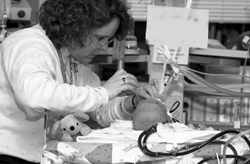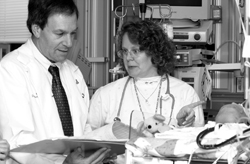By Kara Gavin and Valerie Gliem
Health System Public Relations

C.S. Mott Children’s Hospital has been named to Child magazine’s first list of the 10 Best Children’s Hospitals in America, recognizing its excellence in medical care and research and its emphasis on putting patients and families first.
The list, which will be featured in the February issue of Child that goes on sale Jan. 16, is based on objective data from 178 pediatric hospitals around the nation. Mott was ranked ninth among all hospitals, based on such criteria as the quality of doctors and nurses, survival rates for common childhood cancers and the amount of government research funding it receives.
“We’re delighted by this recognition of our dedication to excellence in caring for seriously ill children and advancing pediatric medicine,” says Gilbert S. Omenn, executive vice president for medical affairs. “This ranking belongs to the faculty, staff and volunteers whose work has made Mott a top-notch hospital for children from Michigan and around the country.”
Patricia Warner, associate hospital director who oversees Mott, says, “For more than 30 years, we have built unique programs to help children overcome or cope with severe illnesses of all kinds. We’re proud to be named among the best, and we congratulate the other top institutions for their dedication to this same ideal.
“We welcome this news,” Warner adds, “which comes while we are developing plans for replacing our current facilities in the interest of keeping pace with innovation, technology and advances in patient-centered clinical care.”
In addition to the overall ranking, Child’s list of “Doctors Who Make a Difference” includes Steven M. Donn, head of Mott’s Holden Neonatal Intensive Care Unit and professor of pediatrics and communicable diseases. Children’s Hospital of Michigan in Detroit also made the top 10 list, as did its chief of pediatric neurosurgery, Alexa Canady, a graduate of the Medical School.
Since 1969, when Mott opened as a separate hospital with 200 licensed beds, its staff has cared for hundreds of thousands of children. In 2000 alone, 10,500 children were admitted, 6,500 underwent operations, and 41,000 were seen on an outpatient basis.
The hospital is named for Flint industrialist and philanthropist Charles Stewart Mott, whose foundation’s $6.5 million gift in 1964 helped make possible the construction of the U-M’s first children’s hospital. University Hospital opened its first separate children’s ward—one of the first in the nation—in 1921. Necessary renovations were made in 1994, again with assistance from the C.S. Mott Foundation.

Today, Mott has grown to include inpatient and outpatient pediatric specialty care in numerous disciplines, a surgical suite with nine operating rooms, the Holden unit for critically ill newborns, a child and adolescent psychiatry inpatient unit, and a pediatric trauma program that is one of only 13 of its kind in North America.
More than 165 physicians from the Medical School faculty see patients at Mott. Many are in the general or specialty sections of the Department of Pediatrics and Communicable Diseases; others come from departments with pediatric divisions or sections, such as anesthesiology, dermatology, ophthalmology, otolaryngology, pathology, physical medicine and rehabilitation, radiology and surgery. All the physicians are board-certified or board-eligible in pediatrics.
This wide range of expertise benefits patients at Mott and beyond, says Jean Robillard, chair of the Department of Pediatrics and Communicable Diseases. “Our patients have the advantage of receiving high-quality care that reflects our emphasis on basic and clinical research, and on training the pediatric leaders of the future,” he says. “We can bring new therapies from the laboratory to the clinic.”
As a unit of the Health System, education and research also are priorities. U-M medical students learn from some of the best pediatric physicians in the nation, while residents and fellows get advanced training in general pediatrics, pediatric emergency medicine and many subspecialties in inpatient and outpatient areas across the Health System.
This also makes it possible for patients to benefit from the latest techniques and therapies through clinical trials conducted at Mott, including the results of clinical and basic laboratory research by U-M scientists. In all, more than $12 million in research funding from government and private sources supported pediatric research at Mott in fiscal year 2000.
Many of Mott’s most widely known programs use a team approach to coordinate care by surgical and medical staff, nurses, therapists and other professionals.
The Michigan Congenital Heart Center, for example, attracts patients as young as a few days old from around the state, nation and world to correct and treat heart defects and other conditions. For more than 70 years, the Craniofacial Anomalies Program has helped children born with cleft lips and other face and skull birth defects.
Mott’s excellence extends beyond medical care. It pioneered the concept of a unit host, an all-purpose “concierge” in each inpatient area to help families. The U-M also had the nation’s first Child Life program, started in 1922 to organize educational and recreational activities to enhance patients’ stays in the hospital. Today, it is widely recognized as one of the best programs in the nation.
About the survey
Child magazine took many factors into account when compiling its list, with the aim of helping parents understand all the components that make a good children’s hospital.
“When a child is seriously ill, a parent wants the best care possible,” says Miriam Arond, editor in chief of Child. “Our survey provides parents with a list of hospitals that conduct cutting-edge research in children’s health and offer exceptional medical care in a sensitive kid- and family-friendly environment.”
Child’s ranking process began with the 178 hospitals that belong to the National Association of Children’s Hospitals and Related Institutions. The magazine then looked at the results of each institution’s evaluation by the Joint Commission on Accreditation of Healthcare Organizations, which accredited all of the U-M’s hospitals and health centers in 1997.
“We spent five months conducting an extensive investigation that was in no way influenced by the opinions of health-care providers,” Arond says. “Unlike other surveys, we sought to evaluate hospitals based solely on the issues such as performance records, the percentage of their staff board-certified in pediatrics, research capabilities and community outreach.”
The 50 finalists received a comprehensive 42-question survey developed by the magazine’s medical advisory board. The survey addressed crucial issues ranging from cancer survival rates to the extent of the hospital’s programs for the emotional needs of patients. Child’s medical advisory board reviewed and evaluated the survey results.
The other top-ranked pediatric hospitals are: Children’s Hospital of Philadelphia; Children’s Hospital, Boston; Children’s Hospital & Regional Medical Center, Seattle; The Children’s Hospital, Denver; Texas Children’s Hospital, Houston; Children’s Hospital of Michigan, Detroit; Children’s Medical Center of Dallas and Children’s Hospital & Health Center, San Diego (tied); and the Medical University of South Carolina Children’s Hospital, Charleston.

